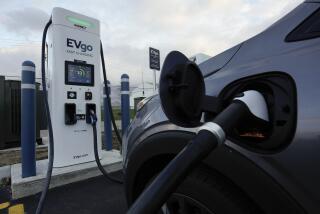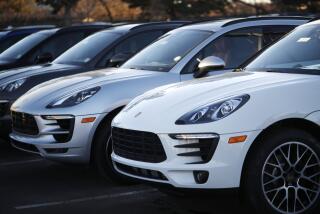Santa’s little helper
More than a few readers have sent messages questioning what, exactly, I value in an automobile. These inquiries have often included helpful suggestions concerning the kind of flying leap I can take and where.
Let me explain. What I value in a car is personality. What I value is character. I value a car that makes me daydream about driving, about romancing the road for hours on end, a white-line idyll without purpose or destination. All I ask is a small ship and a star to steer her by.
If you are searching for causes of dysfunction in America’s love affair with the automobile, the place to start is the focus group flatness that defines most cars today, an enervating perfection that is the product of automakers chasing, in my view, the wrong rabbit.
Almost by definition, character comprises great strengths and certain winning flaws -- does anybody remember Edmund Burke?
The BMW-built 2004 Mini Cooper is not a perfect automobile. Let us just take a moment to let that understatement reverberate: The back seat is the automotive equivalent of a spider hole in Tikrit. The ride is rough enough to disqualify you from future organ donations. Compared with the amniotic hush of a Lexus LS 430 or Volkswagen Phaeton, the Mini’s warbling, static-filled ambience sounds as if it was recorded in Sam Phillips’ Sun Records studio.
But the Mini -- especially the John Cooper Works edition I drove recently -- is a righteous piece, a snubbed-down, amped-up, hot rod Hobbit that turns the most galling stop-and-go errand into an occasion for joyous gear-jamming and games of Diss the SUV. I defy you not to love this car.
And in Los Angeles -- ohmigod -- the car flat-out dogs traffic. With 200 supercharged horsepower on tap, the JCW edition makes a hole in freeway traffic like a satchel charge, nicking around bigger cars and squeezing into openings stingy drivers didn’t know they had left.
With its 97.1-inch wheelbase, 143.9-inch overall length and turning radius of a mere 34.2 feet, the Mini is brought to you by the letter U, as in U-turn. See a parking place on the other side of the street? You are on it like Snoop on a fatty.
A little history is in order. The original Mini was designed by Sir Alec Issigonis in response to the Suez oil crisis of the late 1950s, and its novel configuration -- a transverse-engine, front-wheel drive, four-seat two-door -- created the perfect city car for Europe’s narrow streets and sidewalk parking: cheap, maneuverable, Swiss Army knife versatile.
The car, built wearing the Austin and Morris badges, became a cultural icon as much as the VW Beetle. Issigonis was knighted for his efforts. It starred in one of the great caper films of the 1960s, “The Italian Job,” starring Michael Caine and one thoroughly mortified-looking Noel Coward. Mike Myers borrowed the Austin name for his paisley satyr Austin Powers.
(Obiter dictum, the 2002 remake of “The Italian Job,” featuring the new Minis running the aqueducts in Los Angeles, is a superb piece of glossy, drossy, car-centric filmmaking.)
The trouble with the original 37-horsepower Mini was that it was slower than Christmas. To the rescue came John Cooper, the famed race engineer, whose shop -- or “works” -- banged together what became known as the Mini Cooper, with 65 horses. The car promptly went out and won the Monte Carlo Rally.
Likewise with the new car, the high-performance version of the Mini Cooper S is the product of the John Cooper Works shop. (John has gone on to the great paddock in the sky, but his son Mike carries on.) The base Mini Cooper is powered by a naturally aspirated 1.6-liter engine (a joint DaimlerChrysler-BMW unit built in Brazil) that puts out a noodle-armed 115 horsepower. The Cooper S supercharges the engine, raising the output to 163 horses, and pairs it with a six-speed manual transmission, traction control, sport suspension, hood snorkel and integrated rear spoiler.
The John Cooper Works package -- a bolt-on engine modification kit available through Mini dealers -- shoves a lot more air down the 1.6-liter gullet; using a bigger supercharger, a freer-breathing cylinder head and exhaust system; and a reprogrammed computer chip to control it all as the horsepower is nudged up to 200.
Perfect? Ah, no. To get 200 horses out of a 1.6-liter engine, you will inevitably leave some refinement and tractability on the table. Mini elected not to change the clutch, so when you take off in first gear, the engine inevitably bogs as the clutch catches. A heavier clutch would be welcome. A smooth takeoff requires a lot of clutch slipping. Drop the clutch and big things happen. Zero to 60 mph goes by in a crisp 6.3 seconds, and should you want to risk the ire of park rangers in Death Valley, top speed is 130 mph.
The torque curve is a tad unprogressive, much as getting viciously rear-ended in the bumper-car ride is unprogressive. The supercharger boost comes on at about 2,500 rpm and then the thing goes off like a Waring blender, yanking the car and its rubber-necked passengers to the rpm redline in each gear. The car is bleeding mad with torque from 4,000 to 6,000 rpm (peak torque is 177 pound-feet at 4,000 rpm), which means that with a well-chosen gear in hand, the nearly 2,700-pound car has a wicked punch. All that stands between you and the space ahead of that rolling roadblock -- you know who you are, Lincoln Navigator -- is will.
If you want the big derringer, though, you will have to pay. The JCW package costs $4,500, and it doesn’t come bundled with high-end options, of which there are a dizzying variety. So you are left to kit out the Cooper S the way you want it -- Harmon Kardon stereo, Sirius satellite, navigation system, rain-sensing wipers, heated windshield washer nozzles, dual-pane panoramic sunroof -- then pay the piper for the JCW. In this way can you take a car with a base price of $16,449 and turn it into a $30,000 extravagance.
For some, it would be well worth it. The Cooper JCW is more fun than a pants-full of ferrets. The Cooper S suspension -- derived from the BMW 3-Series and tied together with antiroll bars front and rear -- is incredibly stiff. There is virtually no body lean in corners, and the car has tenacious amounts of grip with the 205/45R 16-inch performance tires.
One note: Our test car had the white alloy wheels, which very quickly get sooty from dust thrown off the 11-inch front brakes.
With its wide stance, short wheelbase and quick steering ratio, the Mini JCW turns on a dime and leaves 11 cents change. The electrohydraulic steering rack is heavy and accurate, and the thick steering wheel fills your hands with a sense of taut control. The car has equal-length half-shafts so that torque steer is virtually nil.
I am surprised how many people, cowered by the truck-frame leviathans loose in the land, ask me whether the Mini is safe. Well, in a head-on with a Suburban, no, but that’s certainly the worst-case scenario. The Cooper won top marks in crash testing from the National Highway Traffic Safety Administration and the Insurance Institute for Highway Safety.
The car is replete with air bags and inflatable side curtains, multiple brake systems (anti-lock, corner brake control and electronic brake-force distribution) and traction and stability controls. But my philosophy is they can’t hit what they can’t catch, so I think the Mini JCW is pretty darn safe.
The car’s interior is beautifully provisioned, with a kind of sassy and spare futurism. The front buckets are extremely comfortable, and with the back seats folded down, the usable cargo space is more than 23 cubic feet -- lots of room for packages and presents.
Our test car -- in the red-and-white livery -- seemed as if it would look even better with a bow on it.
At least it would fit under the tree.
*
Times automotive critic Dan Neil can be reached at dan.neil@latimes.com
*
2004 Mini Cooper S John Cooper Works
Wheelbase: 97.1 inches
Length: 143.9 inches
Curb weight: 2,678 pounds
Powertrain: 1.6-liter supercharged inline-4, six-speed Getrag manual transmission, front-wheel drive
Horsepower: 200 at 6,000 rpm
Torque: 177 pound-feet at 4,000 rpm
Acceleration: Zero to 60 mph, 6.3 seconds
EPA rating: 25 miles per gallon city, 33 highway
Price, as tested: $24,990 (including $550 delivery, $4,500 for JCW kit, $540 for nine hours’ labor to install)
Competitors: Ford Focus SVT, Volkswagen GTi
Final thoughts: Elf-help manual
More to Read
Start your day right
Sign up for Essential California for news, features and recommendations from the L.A. Times and beyond in your inbox six days a week.
You may occasionally receive promotional content from the Los Angeles Times.






